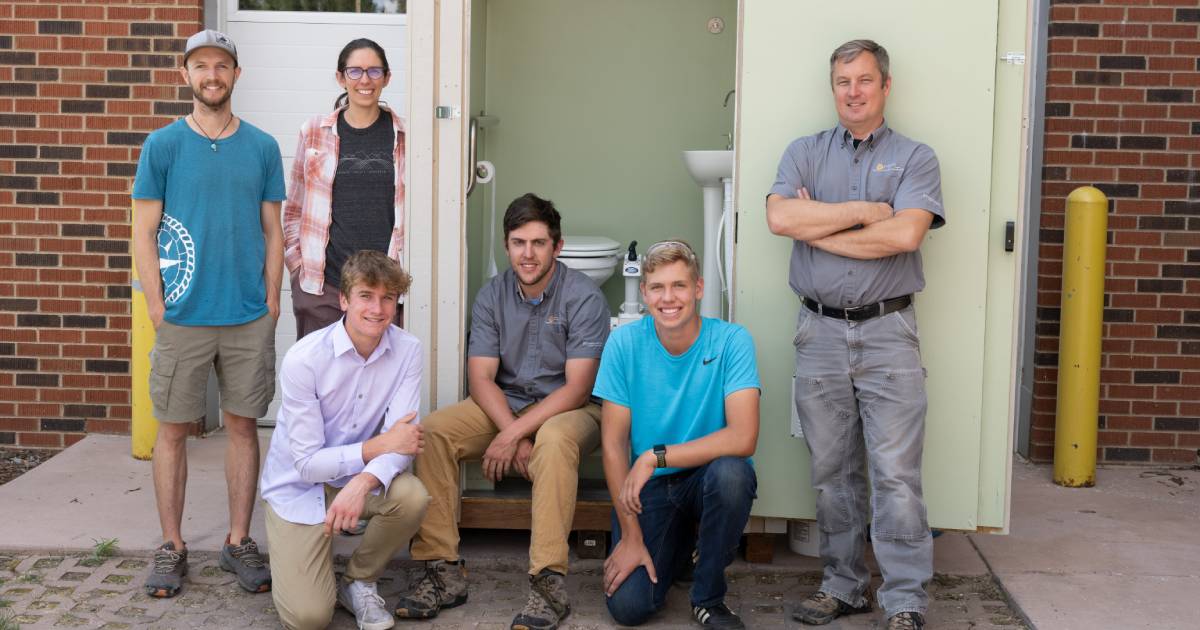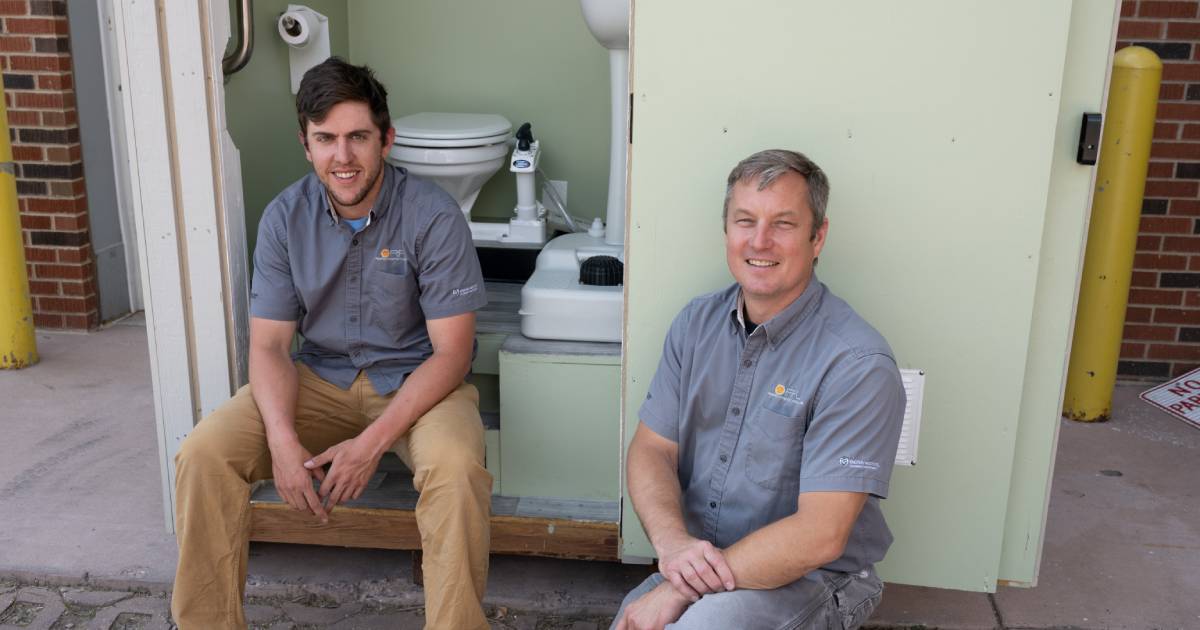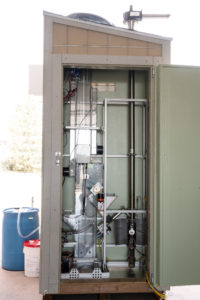
A CSU Energy Institute team has spent many months designing and building a low-cost sanitation system suitable for developing world needs. From left: Andrew Andraski, M.S. student in mechanical engineering; Kelly Banta, research assistant; John Shelby, Poudre School District high school intern; Matt Willman, Rapid Prototyping Lab engineer and manager; Anton Johnson, Poudre School District high school intern; and John Mizia, Rapid Prototyping Lab director and toilet project principal investigator. Photo by John Eisele.
When was the last time you marveled at the sound of a flush toilet? The flick of a handle summons gallons of water to wash away waste, which gets treated and disposed of at far-away facilities. But for too many people across the world, such a convenience is an unattainable luxury.
For nearly a decade, Colorado State University engineers have had their minds on — and sometimes in — the toilet – thinking outside the traditional water closet to create new ways to manage human waste for the billions who lack access to safe sanitation.
Behind the Powerhouse Energy Campus is a humble-looking outhouse that contains a fully integrated, standalone sanitation system. Designed, built and tested by CSU engineers, the toilet inside feeds into a vertically draped, slow-moving chain that collects, dries and pelletizes human feces. The pellets are then burned in an integrated combustor, all without water and using very little power.
For the last several months, engineers at the CSU Energy Institute have been working to perfect the design of their innovative fecal dehydrator and combustor system, with funding from the Bill & Melinda Gates Foundation. They’ve finished three industrial pilot modules, one of which now lives at the Powerhouse Energy Campus, and all of which are being tested in collaboration with research partners at the outdoor gear company MSR.
Toilet challenge redux
John Mizia, lead engineer on the project and a research associate at the CSU Energy Institute, has been a toilet tinkerer for many years. He led the CSU team that entered the Gates Foundation Reinvent the Toilet Challenge in 2013, which spurred the creation of “new toilet technologies that safely and effectively manage human waste.”
Even so, no technology has yet moved the needle on the public sanitation problems many communities still face; it turns out the toilet is a tough nut to crack.
“There were a lot of just crazy technologies that came out of the Toilet Challenge,” said Mizia, whose team at the time provided a fecal combustor for a team from North Carolina’s Research Triangle Institute. “But when you think about the developing world and trying to match the product with the budget someone would have, it’s a real issue, and one that has proven to be very difficult to solve.”

Toilet project lead engineers Matt Willman and John Mizia.
Since the original Toilet Challenge, CSU’s expertise has shined in the back end, if you will, of a waterless toilet. At the time, Mizia and his team had years of experience with burning biomass for cleaner cookstoves, and they turned to the problem of poop. While urine is sterile and relatively easier to deal with, feces are laden with pathogens and cause the most problems in open-defecation environments. Fecal-oral contamination can create serious health issues for humans and animals exposed to bacteria-laden waste.
Mizia’s team devised a semi-gasifier combustor that incinerates feces while minimizing emissions, a system similarly used in CSU-developed clean cookstoves.
With their poop-burning system working well, the engineers were still figuring out the preceding step of drying and pelletizing the feces efficiently before incinerating them. One day, it came to Mizia: What if we dragged a chain through it?
“Everyone was stuck on trying to dry feces immediately with all these complicated systems,” Mizia said. But, he reasoned, people defecate roughly 250 grams of feces per day. It takes about 24 hours to air-dry that amount of poop. So why not take their time?
Chain dryer
That’s when the CSU idea of a slow-moving fecal chain dryer was born. They’ve been working on the toilet in the Energy Institute’s Rapid Prototyping Lab, which Mizia leads, and which affords the team the ability to prototype, test and refine different configurations and designs quickly.
The chain dryer looks very much like a bike chain that hangs vertically into a waste receptacle, where feces are slowly packed in by a roller. A fan similar to the one in your computer provides enough air circulation for drying over a daylong period as the poop slowly moves on the chain. The now-dry poop, pre-pelletized by being packed into the chain, is then ejected into a hopper. When the hopper fills up, the poop pellets are augured into the combustor, which ignites, heats up, switches to a steady-state mode, and fully combusts the fecal material with very little exhaust. The original Reinvent the Toilet Challenge required technologies to dispose of human waste for 5 U.S. cents per day or less; the low-power, low-cost CSU system hits that goal.

“We took the approach of not needing to dry the feces super-fast, but rather in this passive manner,” explained Matt Willman, manager of the Rapid Prototyping Lab and a recent CSU graduate.
Willman has spent countless hours on the toilet project (and endured countless toilet jokes). He said they couldn’t have kept such aggressive timelines without the expertise afforded by the lab.
“We were able to make hardware adjustments and perform integration of systems that would typically take weeks or months if sent to outside vendors,” he said.
Getting down to business
In the last several weeks, the researchers have reached a key milestone in their poop-drying endeavor: testing the real thing. Until recently, they had only tested the chain on simulant feces, which the researchers mixed up using a recipe that NASA also uses.
Students and staff who work at the Powerhouse Energy Campus volunteered to use the toilet to provide samples for the dryer. Since their technology only deals with feces, they built their system around a marine toilet they bought online, which suffices to separate liquids from solids. Data so far indicate that the fecal-drying system is working as expected.
Whether their toilet system becomes the answer to the world’s sanitation problems is anyone’s guess. But CSU engineers, ever mindful of solutions they can attain quickly, are looking at other ways their chain dryer-combustor could be commercialized, even as they continue to test it.
One idea is for pit latrines, which currently require expensive pumping for carrying away waste that’s 80-90 percent water. CSU’s system could offer a cost-effective alternative for emptying latrines by first pulling out most of the moisture, making the waste lighter, more sanitary and easier to move.